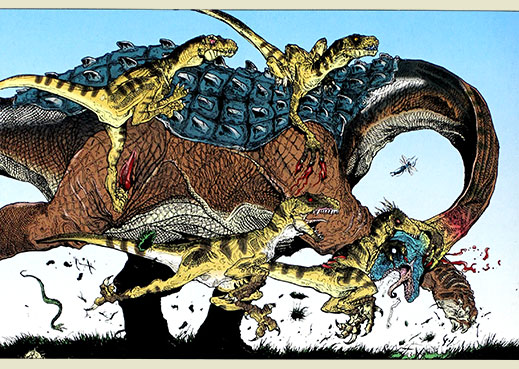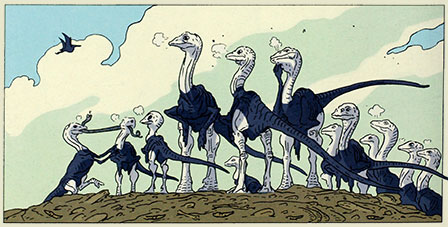Age of Reptiles Omnibus
Created by: Ricardo Delgato, James Sinclair, and Jim Campbell
Published by: PUBLISHER
ISBN: 1595826831 Amazon
Pages: 398



Silent comics are really difficult to pull off well. They've got a lot going against them. Exactly half of the linguistic repertoire being forbidden, the creator is forced to rely wholly upon visual language for all exposition. When characters cannot exposit their own motives to the reader, they must rely on illustrated cues to make their purposes, intents, reasons, and passions both knowable and then known. And as difficult as that sounds, the requirement upon the artist of these characters is phenomenal. Not only does the artist have to reliably draw characters recognizably and convey story through panel-to-panel storytelling transitions (as is the case even in comics featuring dialogue and narration), but beyond this, the artist must be able to convey all those burdens generally carried by the writer of words. Personality. Interaction. Interrogative. Exclamation. Thought. Emotion. Reaction. Success in these tasks takes the hand of a master.
Silent comics are really difficult to pull off well. So it shouldn't surprise or disappoint us to discover that Ricardo Delgado's Age of Reptiles doesn't find a good pace until its final third. This is no slight against Delgado's abilities or craftsmanship. For the one, the silent comic is an incredibly difficult undertaking and I've rarely11Off the top of my head, I can't actually think of any stellar examples beyond Shaun Tan's The Arrival. seen it accomplished well. For the other, he's telling stories in which his characters are dinosaurs, which compounds his storytelling issues expansively. And for the last, Delgado does end up succeeding—it just took him a while (understandably) to find his sea-legs. Delgado takes a high-concept comic fraught with potential but held back by its own experimentations and turns it into a masterpiece.

Age of Reptiles Omnibus, vol 1 is composed of the first three Age of Reptiles miniseries22This volume contains three Age of Reptiles stories: "Tribal Warfare," "The Hunt," and "The Journey." (Published in 1993, 1997, and 2010, respectively.), each following the experiences of some dinosaur or other. Watching Delgado's evolution over these nearly two decades is a pretty wonderful experience. As he ages, one gets the sense that he becomes more and more comfortable with his production. What initially seems (for all its grandeur) forced soon becomes a thing of easy comfortability. His style, technique, and storytelling mature and the direction of his narrative becomes more profound as well.
Delgado's first series, "Tribal Warfare," features very detailed penwork. Every crease, crevice, and fold in his dinosaurs' skin is rendered in crisp black lines. Delgado's attention to detail is somewhat awe-striking, but generally (and despite a good sense of visual presence and doing a lot with negative space) the art in these pages feels exceptionally busy. It's possible that this line-heavy style could have worked with some of today's advanced colouring techniques, but Delgado was stuck with 1993's primitive colouring tools. Instead of softening his drawings' hard edge, his colours are garish and serve mostly to heighten the uncomfortability of his art.

Still, his33I say "his" here, but it's entirely possible that these choices belonged to colourist James Sinclair, who colours both "Tribal Warfare" and "The Hunt." Still, I have a hard time believing that Delgado didn't at least direct Sinclair's choices by laying out a house style. choice here is fascinating. Where he (or colourist James Sinclair) could have made his dinosaurs from a palette of earthy tones—tans, greens, rusts, the occasional spark of a subtle blue—he puts forth a rainbowed array of reptiles. "Tribal Warfare" opens with a lime-green pteranodon whose neck is striped with vibrant white and blue and whose crest is bright yellow with a red-spotted pattern. As well, each wing features a large red spot like a Japanese Zero. There are much more colourful dinosaurs in store. The colouring was dissonant but it did make distinguishing different reptiles easier. Still, while I see what Delgado was aiming for and I think the choice both bold and imaginative, I don't think it ultimately helps so much as it could.
On the positive side we do see Delgado occasionally insert broad vistas or well-positioned actors in ways that presage the wonderful scenes he would produce in the future. In fact, even in his earliest series, Delgado's ability to craft pages that impress is powerful.
The second volume contained in this anthology, "The Hunt," is a step in what looks like a better direction visually. Delgado's work is still incredibly detailed and he sometimes overwhelms his art with his lines, but his pen seems leaner, less heavy on the page. He's not quite there yet, but he's trying something different and that's good. As the book was published in 1997, comics colouring was undergoing a computer revolution. Artists hadn't quite evolved to the point they're at in the late Two-Thousand-Aughts (where colourists like Dave Stewart rule the roost with their phenomenal technique), but as with his linework, it's a step in a healthy direction. Delgado continues to favour wild colour variation for his dinosaurs—only now the transitions of colour on a single beast are less jagged and favour smooth gradients. Strangely, while I think this smoothing works pretty well on his landscapes, for the dinosaurs themselves I actually prefer the abruptness in the colour-design in the earlier work—after all, if you look at the stripes and splotches on a fish at your local pet store, you'll note that they don't gradually fade into the base colour of the fish.
Where "The Hunt" really takes off is in Delgado giving greater reign to his penchant for one- and two-page spreads and to larger set pieces. The third chapter of "The Hunt" is especially compelling, as Delgado takes an excursis from the story of a lone allosaurus to follow several winged pterosaurs in an exciting dogfight. The chapter is filled with gorgeous skyscapes and some scenes of the flying reptiles that could have been cribbed from Miyazaki's Porco Rosso. It was a beautiful chapter and fit (along with chapter four) as a nice break from the less-exciting-though-titular hunt that comprises that volume's storyline.
In the final installment of this omnibus, "The Journey," Delgado seemingly rights all wrongs. Created twelve years after "The Hunt," he's come to a design and illustration sense that is finally easy on the eyes, powerful in communication, and still adept at conveying the wonder of the earlier series' best moments. His style now resembles some happy hybrid between Guy Davis and Mike Mignola. His work is still incredibly detailed, but he shows a marvelous sense of restraint, allowing abstraction where needed. As well, there are moments such as a partially devoured anklyosaur floating in a river that are magnified by Delgado's talent with framing and negative space (I think it may have been this instance that put me most in mind of Mignola). What may be most jaw-droppng in "The Journey" is just how many dinosaurs Delgado draws on every page. His story calls for it for sure, but it's still a minor wonder to behold.
Further, colouring for the book has come into its own at last. I'm not sure if the solution was bringing Jim Campbell on as colourist or if it was just a matter of Delgado witnessing the evolution of computer colouring over the intervening decade. Whatever the case, "The Journey" makes Age of Reptiles a beautiful book. The colours are muted and more in line with what a reader might expect from a book about dinosaurs. Delgado's reptiles still have distinctive markings but they aren't any longer gaudy, flamboyant party-goers. Bravo, whoever was responsible for the shift.
Where "The Journey" also excels over the prior two series is in story. To illustrate, however, I'll have to complain about something central to the earlier two books.
The reason, presumably, that Delgado chose to make Age of Reptiles a silent work is that dinosaurs are not people. They presumably have little facility for language and if they did and we could translate it, their way of conveying meaning might be so alien to us that we wouldn't understand anyway. My guess is that this book was made wordless in a bid for realism.44Interestingly, Delgado doesn't even use onomatopoeia. No sound effects. No grunts or growls or moans. This, I think, is a great idea. Too often, creators will personify their creatures through clever use of animal noises that stand in for human intonation. A dog that looks quizically and says: "ARF?" Question mark included. Any sense that this is a real dog is shattered the moment he says ARF with a question mark attached. It's a good idea if one can do it well— and by time "The Journey" arrives, Delgado is doing it well.

The problem, if realism is Delgado's reason for not verbalizing anything, is that the first two stories are built almost entirely on personification. "Tribal Warfare" features a grudge between a family of T-rexes and a family of utahraptors (I think they're utahraptors). The lead tyrannosaurus scares the raptors off their fresh, rightful kill and initiates a back-and-forth war of attrition that lasts four chapters and ends in all-out battle. It's a fine story but not a fine dinosaur story unless you want your dinosaurs fixed with embedded human motivation. "The Hunt" follows a young allosaur as he flees from the murder of his mother by some wildly coloured raptors. Their pursuit of him lasts for what seems years. Long enough at least for him to grow to full-size. Both the raptors' dogged pursuit of the allosaur despite there being far more docile game everywhere and the allosaur's plan to revenge himself against them left me incredulous. I couldn't be sure why Delgado didn't just give these animals voices if he was going to give them human motivation.

"The Journey" solves this problem in two ways. The first is that Delgado gives no opportunity for these reptiles to act in any way other than as the animals they are. The other is that "The Journey" is not the story of a dinosaur protagonist but instead the story of a massive migration. I'm reminded of Planet Earth's segment on the migration in Africa toward the Okavango Delta. Delgado depicts a collection of herbivore dinosaur herds moving from arid lands toward a lush forest. Their way is perilous and they are followed closely and picked at by predators. If there is a protagonist at all, it is the combined herd, striving forward while being winnowed and whittled. It's magnificent and I'm so very glad that Delgado chose this direction for the third series.
While "Tribal Warfare" and "The Hunt" are each forgettable, "The Journey" makes me curious if there will be a fourth series. I will read it if there is, because Ricardo Delgado has improved that much.
Good Ok Bad features reviews of comics, graphic novels, manga, et cetera using a rare and auspicious three-star rating system. Point systems are notoriously fiddly, so here it's been pared down to three simple possibilities:
3 Stars = Good
2 Stars = Ok
1 Star = Bad
I am Seth T. Hahne and these are my reviews.
Browse Reviews By
Other Features
- Best Books of the Year:
- Top 50 of 2024
- Top 50 of 2023
- Top 100 of 2020-22
- Top 75 of 2019
- Top 50 of 2018
- Top 75 of 2017
- Top 75 of 2016
- Top 75 of 2015
- Top 75 of 2014
- Top 35 of 2013
- Top 25 of 2012
- Top 10 of 2011
- Popular Sections:
- All-Time Top 500
- All the Boardgames I've Played
- All the Anime Series I've Seen
- All the Animated Films I've Seen
- Top 75 by Female Creators
- Kids Recommendations
- What I Read: A Reading Log
- Other Features:
- Bookclub Study Guides











